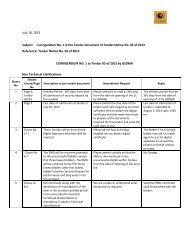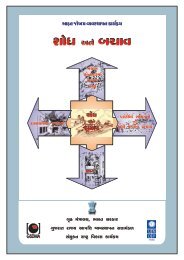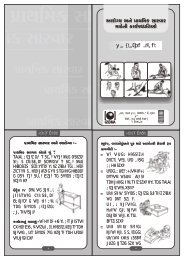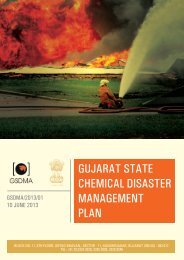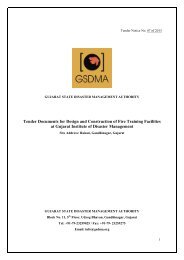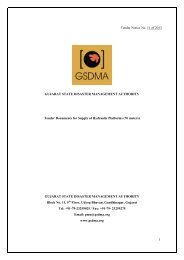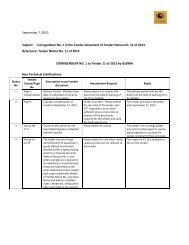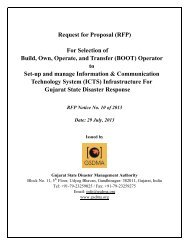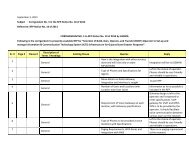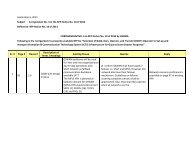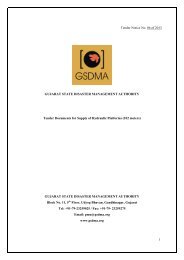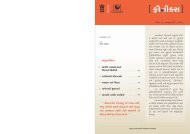Emergency Response Guidebook - Gujarat State Disaster ...
Emergency Response Guidebook - Gujarat State Disaster ...
Emergency Response Guidebook - Gujarat State Disaster ...
Create successful ePaper yourself
Turn your PDF publications into a flip-book with our unique Google optimized e-Paper software.
GlossaryGlossaryAEGL(s)AEGL-1AEGL-2AEGL-3Alcohol resistant foamAcute Exposure Guideline Level(s), AEGLs represent thresholdexposure limits for the general public after a once-in-alifetime, orrare, exposure and are applicable to emergency exposure periodsranging from 10 minutes to 8 hours. Three levels AEGL-1, AEGL-2 andAEGL-3 are developed for each of five exposure periods (10 and 30minutes, 1 hour, 4 hours, and 8 hours) and are distinguished byvarying degrees of severity of toxic effects; see AEGL-1, AEGL-2 andAEGL-3.AEGL-1 is the airborne concentration (expressed as parts per millionor milligrams per cubic meter [ppm or mg/m3]) of a substance abovewhich it is predicted that the general population, includingsusceptible individuals, could experience notable discomfort,irritation, or certain asymptomatic, non-sensory effects. However,the effects are not disabling and are transient and reversible uponcessation of exposure.AEGL-2 is the airborne concentration (expressed as ppm or mg/m3)of a substance above which it is predicted that the generalpopulation, including susceptible individuals, could experienceirreversible or other serious, long-lasting adverse health effects or animpaired ability to escape.AEGL-3 is the airborne concentration (expressed as ppm or mg/m3)of a substance above which it is predicted that the generalpopulation, including susceptible individuals, could experience lifethreateninghealth effects or death.A foam that is resistant to “polar” chemicals such as ketones andesters which may break down other types of foam. Biological agentsLiving organisms that cause disease, sickness and mortality inhumans. Anthrax and Ebola are examples of biological agents. Referto GUIDE 158.Blister agents (vesicants) Substances that cause blistering of the skin. Exposure is throughliquid or Vapour contact with any exposed tissue (eyes, skin, lungs).Mustard (H), Distilled Mustard (HD), Nitrogen Mustard (HN) andLewisite (L) are blister agents. Symptoms: Red eyes, skin irritation,burning of skin, blisters, upper respiratory damage, cough,hoarseness.Blood agentsBurnCBRNChoking agentsCO2Cold zoneCombustible liquidCompatibility GroupSubstances that injure a person by interfering with cell respiration (theexchange of oxygen and carbon dioxide between blood and tissues).Hydrogen cyanide (AC) and Cyanogen chloride (CK) are blood agents.Symptoms: Respiratory distress, headache, unresponsiveness, seizures,coma.Refers to either a chemical or thermal burn, the former may be caused bycorrosive substances and the latter by liquefied cryogenic gases, hotmolten substances, or flames.Chemical, biological, radiological or nuclear warfare agent.Substances that cause physical injury to the lungs. Exposure is throughinhalation. In extreme cases, membranes swell and lungs become filledwith liquid (pulmonary edema). Death results from lack of oxygen; hence,the victim is “choked”. Phosgene (CG) is a choking agent.Symptoms: Irritation to eyes/nose/throat, respiratory distress, nauseaand vomiting, burning of exposed skin.Carbon dioxide gas.Area where the command post and support functions that are necessaryto control the incident are located. This is also referred to as the cleanzone, green zone or support zone in other documents. (EPA StandardOperating Safety Guidelines, OSHA 29 CFR 1910.120, NFPA 472)Liquids which have a flash point greater than 60oC (140oF) and below93oC (200oF). U.S. regulations permit a flammable liquid with a flashpoint between 38oC (100oF) and 60oC (140oF) to be reclassed as acombustible liquid.Letters identify explosives that are deemed to be compatible. Thedefinition of these Compatibility Groups in this Glossary are intended tobe descriptive. Please consult the transportation of dangerousgoods/hazardous materials or explosives regulations of your jurisdictionfor the exact wording of the definitions. Class 1 materials are consideredto be “compatible” if they can be transported together withoutsignificantly increasing either the probability of an incident or, for a givenquantity, the magnitude of the effects of such an incident.Page 376ASubstances which are expected to mass detonate very soon afterfire reaches them.Page 377



